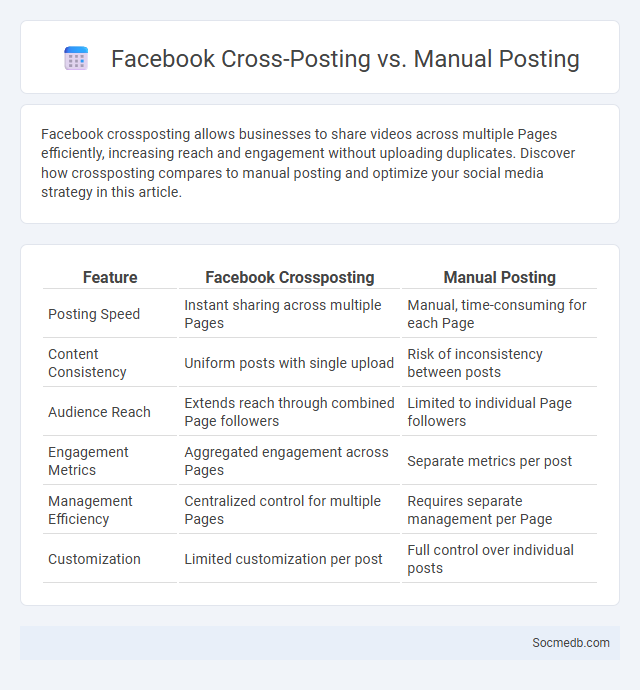
Photo illustration: Facebook Crossposting vs Manual Posting
Facebook crossposting allows businesses to share videos across multiple Pages efficiently, increasing reach and engagement without uploading duplicates. Discover how crossposting compares to manual posting and optimize your social media strategy in this article.
Table of Comparison
| Feature | Facebook Crossposting | Manual Posting |
|---|---|---|
| Posting Speed | Instant sharing across multiple Pages | Manual, time-consuming for each Page |
| Content Consistency | Uniform posts with single upload | Risk of inconsistency between posts |
| Audience Reach | Extends reach through combined Page followers | Limited to individual Page followers |
| Engagement Metrics | Aggregated engagement across Pages | Separate metrics per post |
| Management Efficiency | Centralized control for multiple Pages | Requires separate management per Page |
| Customization | Limited customization per post | Full control over individual posts |
Introduction to Facebook Crossposting and Manual Posting
Facebook crossposting allows you to share the same video content across multiple Facebook Pages without uploading it repeatedly, increasing your reach and engagement efficiently. Manual posting involves individually uploading and customizing posts for each Page, giving you precise control over captions and targeting. By understanding both methods, you can optimize your social media strategy to maximize your content's visibility and interaction.
What is Facebook Crossposting?
Facebook Crossposting is a feature allowing pages to share video content seamlessly across multiple Facebook Pages without uploading separate copies. This tool enhances content reach and engagement by enabling videos to appear natively on different Pages, preserving views and comments as a single video entity. Crossposting is especially beneficial for businesses managing multiple brand Pages or collaborators looking to maximize exposure efficiently.
Understanding Manual Posting on Facebook
Manual posting on Facebook involves creating and publishing content directly on the platform without the use of automation tools or third-party schedulers. This method allows users to tailor posts in real-time, ensuring immediate engagement with followers through comments, reactions, and shares. Understanding manual posting is essential for managing timely updates, personalized interactions, and monitoring organic reach and post-performance metrics directly within Facebook's Insights.
Differences Between Crossposting and Manual Posting
Crossposting involves sharing the same content across multiple social media platforms simultaneously, streamlining content distribution and maintaining brand consistency. Manual posting requires creating unique posts tailored to each platform's audience, which can increase engagement through customized messaging and optimized formatting. Understanding these differences helps marketers balance efficiency and personalization in social media strategies.
Advantages of Facebook Crossposting
Facebook crossposting enables efficient content distribution across multiple Pages, enhancing audience reach without duplicating efforts. It improves engagement by delivering consistent messages to various target groups while maintaining centralized post management and analytics. This strategy streamlines marketing workflows, saving time and resources for businesses and content creators.
Benefits of Manual Posting on Facebook
Manual posting on Facebook allows for greater control over content quality and timing, enhancing audience engagement through personalized interaction. This method helps avoid algorithmic suppression often experienced with automated posts, thereby increasing organic reach and visibility. Direct management of posts also enables immediate responses to audience feedback, fostering stronger community relationships and brand loyalty.
Challenges and Limitations of Both Methods
Social media platforms often face challenges such as algorithm bias and privacy concerns, which limit the accuracy and reliability of user engagement metrics. Both organic and paid methods struggle with ad fatigue and reduced reach due to changing platform policies and audience behavior. Understanding these limitations helps you tailor strategies that maximize effectiveness despite inherent constraints.
Ideal Use Cases: When to Crosspost vs Manual Post
Crossposting is ideal for sharing identical content across multiple social media platforms quickly, maximizing reach and maintaining brand consistency with minimal effort. Manual posting works best for tailored messages that cater to specific audience preferences, platform algorithms, or when customized captions and hashtags enhance engagement. Brands aiming for efficiency benefit from crossposting, while those seeking targeted interaction prioritize manual posting to optimize content relevance and user experience.
Best Practices for Effective Facebook Post Strategy
Crafting an effective Facebook post strategy involves understanding your target audience's preferences and posting content that resonates with their interests and behaviors. You should prioritize high-quality visuals, concise captions, and clear calls to action to boost engagement and reach. Regularly analyzing post performance metrics enables you to refine your content strategy for maximum impact and audience growth.
Conclusion: Choosing the Right Posting Method for Your Brand
Selecting the optimal posting method for your brand hinges on understanding platform algorithms, audience engagement patterns, and content formats that drive maximum reach. Prioritize consistency in posting schedules while tailoring messages to resonate authentically with your target demographic. Leveraging analytics tools to monitor performance ensures continuous optimization and alignment with evolving social media trends.
 socmedb.com
socmedb.com